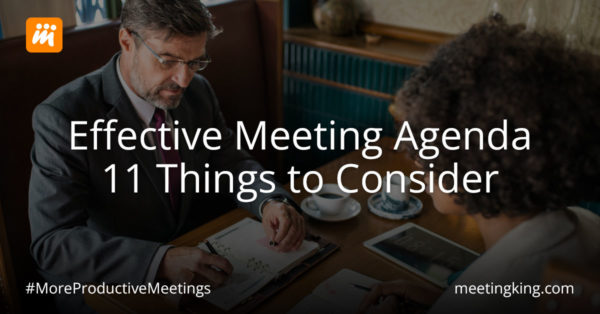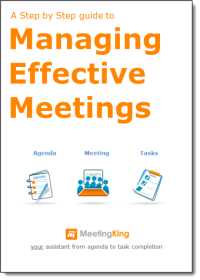
Having a meeting agenda is one of the most powerful tools for a successful meeting. A structured agenda provides guidance for you and your team to come prepared to get down to business! Everyone will be motivated to get the most out of the meeting which in return, will save you a lot of time.
What aspects should you consider when writing a meeting agenda? Let’s find out!
1. Revisit the Information
Before writing a meeting agenda, it is useful to take a look at your notes from your previous meeting. Reviewing this information will remind you of the previous objectives, who was responsible for completing each task, and enable you to check the progress of each project.
2. Identify the Objective of the Meeting
Defining the objective of your meeting is one of the most important steps. In fact, each item on your agenda should directly relate back to it. Your goals should be crystal clear and achievable to make your meeting feel focused.
Having a clear objective in mind also helps in writing the meeting agenda itself. You are less likely to forget an important topic that helps you get to the desired outcome.
3. Share the Agenda in Advance
If you want your upcoming meeting to go smoothly, share the agenda ahead of time. This allows your colleagues to familiarize themselves with the content and suggest any additional items that you might have overlooked.
4. Ask for Input
Most effective meetings are those that are collaborative. One way to encourage participation is to ask attendees if there is anything related to the topic that they would like to add to the agenda. A discussion should always be a dialogue, not a monologue. Asking for their input will make sure that you have considered every individual’s personal perspective which displays your appreciation for team members and colleagues. Not only will this improve your leadership qualities but it will also make your meeting more productive and engaging.
5. Include Questions
Add the most important questions you would like to have resolved in your meeting agenda. By doing so, you give your colleagues an opportunity to look into possible creative solutions ahead of time. As a result, your discussions can become more meaningful, with well-thought-out arguments and in the end a much more productive outcome.
6. Define the Purpose of Agenda Items
Typically, an agenda item (or topic) can be put into one of three categories – informational, discussion topic, and action item. When you are preparing the next meeting agenda, make it clear which item belongs in each category. As a result, attendees will know if you are sharing information, seeking their input, or want to make a decision.
7. Group Agenda Items
To boost efficiency, categorize your agenda items so that they follow a logical order. For instance, start with informational items to make sure everyone is up to speed. Then you can move to a discussion and make informed decisions.
8. Allocate Time for Each Item
Estimate sufficient time for every task and write it next to each item on the meeting agenda. This serves a few purposes. It can help to manage your team’s expectations. You are able to signal the importance of each point you are going to make and you can make sure to have enough time to cover all the items.
Allocate a couple of extra minutes toward the end of the session for quick-fire questions. It’s always better to have a meeting that runs short instead of going overtime, as long as your planning has enabled you to keep things on track.
9. Identify Leading People
Some meetings will require other team members to lead certain topics. For example, if you are organizing an event, you are most likely sharing responsibilities for different tasks. If you want people in charge of these tasks to present updates, add their names to the meeting agenda. This way they have enough time to come to the meeting prepared.
10. Add Relevant Documents to the Agenda
If there are any materials that you want your attendees to get acquainted with beforehand, attach them to the meeting agenda. This way everyone will be on the same page and ready to contribute. Also, the meeting itself will be more constructive because your team will have a good idea of what to expect.
11. Pro Tip: Use Meeting Management Software
Meeting agenda and meeting minutes software like MeetingKing has all the key features for a productive work session. It helps you prepare the agenda, take meeting minutes, share documents, assign tasks, and much more. All information is conveniently in one place allowing you to keep all relevant data to hand which makes it even easier to track your progress toward a successful outcome.
You can easily test all MeetingKing features with our FREE 30 days trial.
If you keep these tips in mind when preparing your next meeting agenda, you are sure to have a more efficient, collaborative, and focused meeting. The attendees will be more motivated, feel appreciated, and will not have the sense that they are wasting time. Moreover, you will be more likely to reach the desired outcome.
__
The image above by rawpixel.com on Freepik


